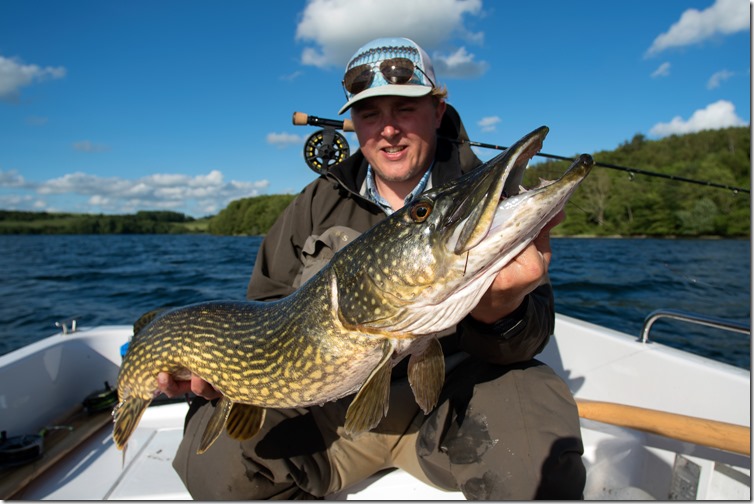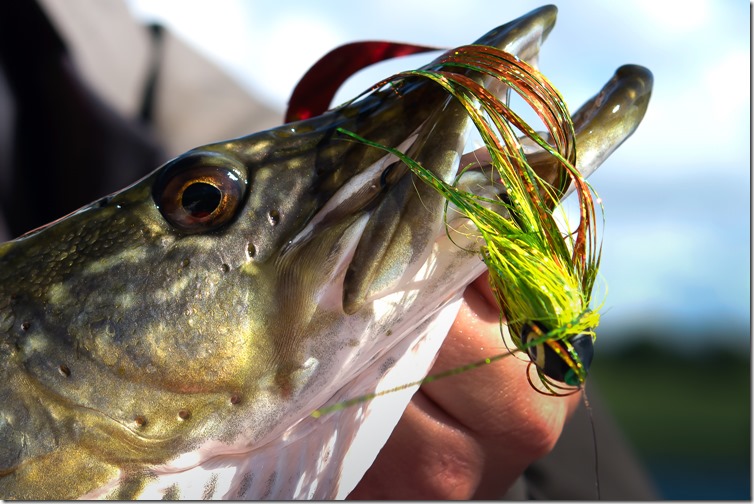When tying pike or muskie flies, you are faced with the laws of physics. You want to use a big fly in order to get the attention of the top predators. But you still want to be able to handle that fly on a single-handed fly rod that you are able to cast all day. In fact the same challenges are equally relevant when tying any kind of large streamer fly… for predatory trout or most kinds of saltwater fly fishing. But for this blog… let’s stick to flies primarily designed for pike and muskie.
Basically the fly should look huge under water – and still be as light as possible and have good aerodynamic proportions when flying over your shoulder during casting.
Creative fly tiers all over the world has worked out solutions for that problem, and there are a number of different strategies to choose from.
Big defined
It is worth remembering, that bigger isn’t always better. Even large predators can focus on smaller baitfish… if they are plentiful and easy prey. But sometimes big is best. And let’s calibrate our bigometer:
If you mostly sling standard nymphs and dry flies for trout, you might find a size 6 muddler minnow big. But that does not even get in the ballpark. Big flies in this world are 8… 10 or maybe even 12 inches (and some nerds go even bigger).
We are talking flies that equal the size of a one or two pound baitfish. It goes without saying that these monsters takes quite an amount of fly tying materials – which might be the reason that fly shop owners love them ;0)
But if you don’t put some thought into your choice of materials… and into fly design – you might end up trying to cast something with the heft of a stuffed thanksgiving turkey on your fly rod.
Synthetics doesn’t suck
As a rule of thumb natural materials soak up more water than synthetics. That is one of the reasons why al sorts of flash fibres and synthetic hackles/flash chenille are very popular for these flies. Flash based flies have lot’s of movement and shimmer – and they throw the water as soon as they are airborne.
Fake it till you make it
Use a construction that supports the concept of big in the water/small above water. Building the bulk up in sections, and using bumps of materials behind the tie in points may be a solution. Take inspiration from steelhead flies that often feature extreme examples of this strategy.
Bob Popowics’ Hollow Fleye reverse tying style is using a natural material (bucktail) to achieve the same goal: Faking volume.
Push and rattle
Pushing water makes sense – especially if you fish in stained waters, under low light condition… or just about any fishing situation, where the predators has to rely on sound and vibrations picked up by their lateral line.
Pike and muskie are typically considered sight feeders, but in waters with low visibility the lateral line system has an important role in capturing the prey.
Pushing water causes disturbance and create sound… as do rattles build into the fly. To the predator more sound and vibration might signal a larger prey… even though it actually is kind of faking as well.
Tail chasing
Large wiggly or curly plastic tails that slowly roll at the butt end of your fly calls for attention. And make your fly look huge.
Or go Natural and deal with it
Zonkers, bunnies and all sorts of strip flies are deadly in the water. They can be pretty tiring to cast all day, but fly lines has come a long way :0) Natural materials are still useful, beautiful and aesthetic pleasing to the eye. Combinations of synthetics and natural materials bridge the gap – but might be more of a work out.
Peter Lyngby ties a Zap Goo Flash Streamer
In this Friday’s fly tying sbs video Danish fly fisher and fly tier Peter Lyngby use a PR350 Light Predator # 4/0 hook, a few synthetic materials and a smart construction to make a light fly look like a really large baitfish. This fly is big: 11 to 12 inches. You might take it for your standard flash fly until you notice the head. Peter builds a light pyramid shaped cone with Zap Goo and pulls the flash fibres out, to give the fly a larger profile in the water. Check out the video and see for yourself…
Have a nice weekend :0)
Michael



